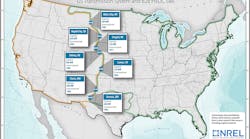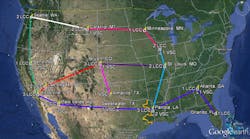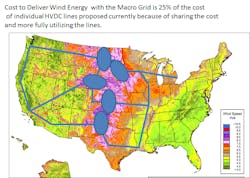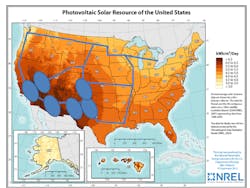Generation Interconnection with the Proposed Macrogrid and FERC Order 1000 Requirements
Last month the Digital Innovations newsletter explored HVDC grids and DC circuit breakers. Another friend of mine, Dale Osborn, has been doing some very interesting work with the proposed Macrogrid and FERC Order 1000. I thought it would be interesting to continue with him as my guest in this month’s feature column. Dale worked 44 years in the power industry as a transmission planner, a power resource planner and with HVDC and SVC system studies. He has a BS and MS of EE from the University of Nebraska. He has worked for the Nebraska Public Power District, with ASEA-ABB work with HVDC and SVCs, and retired from MISO in 2017. He is currently working with NERL on the NERL Interconnections SEAM study investigation tying the Western, Eastern, and Electric Reliability Council of Texas Interconnections together with an HVDC network overlay called the Macro Grid.
Enjoy,
Gene
The proposed Macrogrid is an HVDC network overlay over about three-fourths of the United States. Preliminary analysis indicates that the annual benefits from multiple uses of the HVDC overlay may exceed the annual costs (revenue requirements) of the transmission. Benefits are derived from using existing generation capacity in different time zones more efficiently by making generation available over the Macro Grid footprint.
An obvious question is why the Northeastern quadrant of the United States is not included in the Macrogrid footprint. The answer is that the Macrogrid is largely economically justified through peak period generation capacity exchanges of load capacity diversity. Load capacity diversity is mainly driven by the time zone differences. The peak need for generation is later in the day in California than in Atlanta, Georgia. With HVDC transmission of the Macrogrid, generation capacity and energy can be delivered over such long distances and through asynchronous interconnection generation in California and can be used to serve the Georgia peak load earlier in the day. Georgia generation can be used to serve California load later in the day. The present AC system cannot do this.
In exchanges of quantities, the smaller entity’s supply sets the limit on the exchange. WECC, the western United States, only has enough load diversity capacity to fill the Macrogrid footprint. Building more transmission to serve the northeastern quadrant of the United States would increase cost, but not increase benefits greater than the cost
High energy potential wind generation sites and high energy potential solar sites lie within the Macro Grid footprint. Figure 2’s purple zone is the location of the potentially highest wind producing areas in the U.S. The blue ovals represent areas of collection of wind generation energy and the delivery to blue lines of the Macrogrid. The Macrogrid offers an efficient harvesting of high potential wind energy generation production and an efficient delivery system to major loads on the west coast and center of the United States.
Up to date, wind generation has primarily been interconnected to AC transmission within utilities, RTOs and ISOs in the ratings of a few hundred MW or less. The Macrogrid provides the capability of connecting wind generation directly to the HVDC overlay in large quantities.
The ovals on the map in Figure 2 could represent HVDC-wind generation collection terminals rated at 5,000-6,000 MW. Each HVDC line in the Macrogrid is rated at about 6,000 MW. Each oval would probably have AC lines feeding the HVDC terminals intersecting the lines in the oval. The Macrogrid could distribute the wind energy over the Macrogrid footprint.
Figure 3 shows the location of high potential solar energy generation sites that may be able to collect solar energy and deliver it over the Macrogrid footprint. The Macrogrid could also distribute 10,000 MW or more of solar energy over the Macro Grid footprint.
Figure 4 shows gas fields near or within the Macrogrid footprint. The Macrogrid could deliver peaking generation over its footprint. Some of the gas fields are in the middle of the Macrogrid footprint and could have energy from gas peaking generation scheduled in either direction from the gas sources. The middle location would reduce losses since the delivery distance is shorter. Some gas pipelines may not be needed as the Macrogrid would supply the energy where needed. Gas generation hubs of several thousand MW may also be possible with the Macrogrid.
A Voltage Source Converter HVDC terminal does not have to be connected to a strong AC transmission system as older Load Commutation Converter type HVDC systems. Thus generation could be connected in quantities that the existing AC systems could not support without the VSC HVDC terminals.
VSC HVDC terminals can also extract not only the wind generation for transmission, but the exact pattern of the wind generation. Thus limitations of the present AC systems to manage the variability of wind or solar resources from large renewable generation sites can be removed by the use of VSC HVDC to remove the impacts of renewable generation from local AC transmission.
Areas with weak AC transmission, lack of significant loads to absorb renewable generation and low levels of regulating generation would be limited to the amount of renewable generation development without the VSC HVDC terminals connected to the Macrogrid. The HVDC Macrogrid can transmit energy over a large geographic footprint more efficiently and economically than AC systems. Development of large scale, high potential renewable energy areas at competitive costs may be possible with Macro Grid.
The VSC HVDC renewable zones may be able to operate as asynchronous islands and not be connected to the local AC transmission if the local AC transmission is a limiting factor to the development of economical renewable resources.
The Macrogrid, as shown in Figure 1 is designed to:
- Displace 30,000 MW of peaking generation
- Delivery 30,000 MW+ of renewable generation: Typical wind/solar ratios are about 2/1; 20,000 MW of wind and 10,000 MW of solar generation may be expected to be connected to the Macrogrid.
- Renewable generation may be connected to the AC system for local use.
Load Capacity Diversity exchanges, wind energy and solar energy use the Macrogrid primarily at different times of the day. Less transmission is needed to serve the multiple uses than if each use had its own transmission. The multiple users of the Macrogrid reduce the cost of the Macrogrid.





